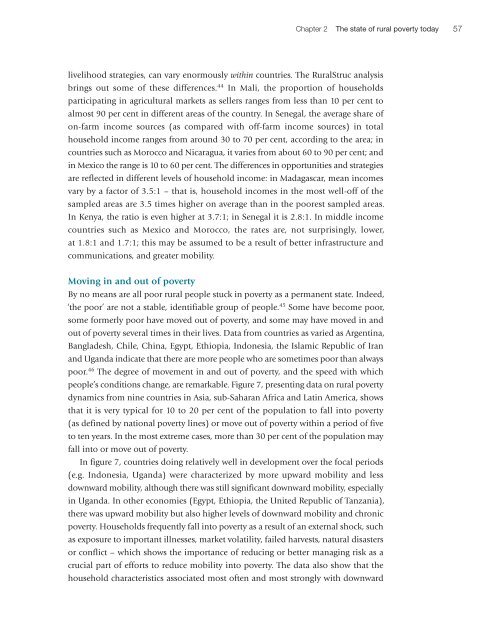English - IFAD
English - IFAD
English - IFAD
You also want an ePaper? Increase the reach of your titles
YUMPU automatically turns print PDFs into web optimized ePapers that Google loves.
Chapter 2 The state of rural poverty today 57<br />
livelihood strategies, can vary enormously within countries. The RuralStruc analysis<br />
brings out some of these differences. 44 In Mali, the proportion of households<br />
participating in agricultural markets as sellers ranges from less than 10 per cent to<br />
almost 90 per cent in different areas of the country. In Senegal, the average share of<br />
on-farm income sources (as compared with off-farm income sources) in total<br />
household income ranges from around 30 to 70 per cent, according to the area; in<br />
countries such as Morocco and Nicaragua, it varies from about 60 to 90 per cent; and<br />
in Mexico the range is 10 to 60 per cent. The differences in opportunities and strategies<br />
are reflected in different levels of household income: in Madagascar, mean incomes<br />
vary by a factor of 3.5:1 – that is, household incomes in the most well-off of the<br />
sampled areas are 3.5 times higher on average than in the poorest sampled areas.<br />
In Kenya, the ratio is even higher at 3.7:1; in Senegal it is 2.8:1. In middle income<br />
countries such as Mexico and Morocco, the rates are, not surprisingly, lower,<br />
at 1.8:1 and 1.7:1; this may be assumed to be a result of better infrastructure and<br />
communications, and greater mobility.<br />
Moving in and out of poverty<br />
By no means are all poor rural people stuck in poverty as a permanent state. Indeed,<br />
‘the poor’ are not a stable, identifiable group of people. 45 Some have become poor,<br />
some formerly poor have moved out of poverty, and some may have moved in and<br />
out of poverty several times in their lives. Data from countries as varied as Argentina,<br />
Bangladesh, Chile, China, Egypt, Ethiopia, Indonesia, the Islamic Republic of Iran<br />
and Uganda indicate that there are more people who are sometimes poor than always<br />
poor. 46 The degree of movement in and out of poverty, and the speed with which<br />
people’s conditions change, are remarkable. Figure 7, presenting data on rural poverty<br />
dynamics from nine countries in Asia, sub-Saharan Africa and Latin America, shows<br />
that it is very typical for 10 to 20 per cent of the population to fall into poverty<br />
(as defined by national poverty lines) or move out of poverty within a period of five<br />
to ten years. In the most extreme cases, more than 30 per cent of the population may<br />
fall into or move out of poverty.<br />
In figure 7, countries doing relatively well in development over the focal periods<br />
(e.g. Indonesia, Uganda) were characterized by more upward mobility and less<br />
downward mobility, although there was still significant downward mobility, especially<br />
in Uganda. In other economies (Egypt, Ethiopia, the United Republic of Tanzania),<br />
there was upward mobility but also higher levels of downward mobility and chronic<br />
poverty. Households frequently fall into poverty as a result of an external shock, such<br />
as exposure to important illnesses, market volatility, failed harvests, natural disasters<br />
or conflict – which shows the importance of reducing or better managing risk as a<br />
crucial part of efforts to reduce mobility into poverty. The data also show that the<br />
household characteristics associated most often and most strongly with downward

















